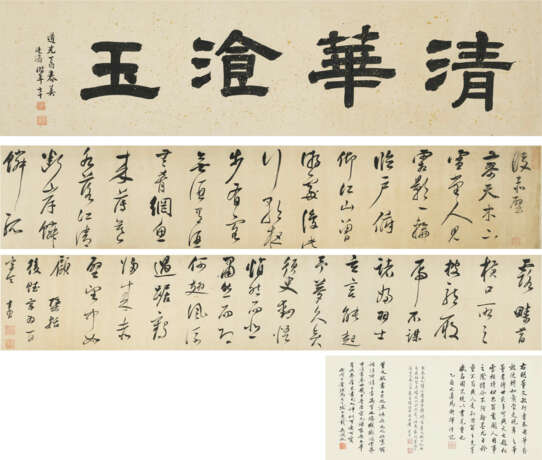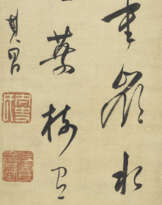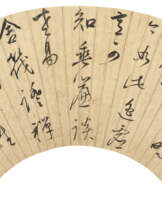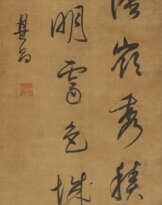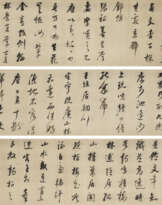ID 1086699
Lot 846 | DONG QICHANG (1555-1636)
Valeur estimée
HKD 400 000 – 600 000
Poems in Running-Cursive Script
Handscroll, ink on satin
26.5 x 290 cm. (10 ½ x 114 1⁄8 in.)
Inscribed and signed, with three seals of the artist
One collector’s seal of Wang Shiyuan (1877-1951)
Frontispiece by Zhang Tingji (1768-1848), signed, with two seals of the artist
Dated spring, dingyou year of the Daoguang period (1837)
Colophons by Ma Heng (1881-1955), Huang Baowu (1880-1968) and Wu Hufan (1894-1968), signed, with a total of four seals
Further details
Archaicism and Individuality - An Overview of Six Ming Calligraphers
Like poetry writing, Ming calligraphers celebrate classicism and archaic revival through studying model calligraphy of ancient masters without being copy slaves (as advocated by Li Yingzhen) while retaining one’s character. Such practice reverberates the core value of Ming philosophy to discover one’s inner thought.
Highlighted in this season are eight magnificent Ming calligraphic works, including three handscrolls - Cursive Script Calligraphy by Zhu Yunming (Lot 843), Poems in Cursive Script by Wen Zhengming (Lot 844) and Poems in Running-Cursive Script by Dong Qichang (Lot 846). A magnanimous man of free spirit, Zhu Yunming’s grandfather Xu Youzhen and father-in-law Li Yingzhen were renowned calligraphers. Zhu’s talents and prestigious upbringing enabled him to triumph in cursive script calligraphy. Executed in bold and courageous manner, the drastic turns and liberating strokes provoke a sense of wildness and divinity in Lot 843. Wen Zhengming studied calligraphy under Li Yingzhen. Earnest and diligent, Wen was a versatile artist who seldom wrote in cursive script. Lot 844 shows a subtle elegance that summoned the spirit of a nobleman. Dong Qichang pursued painting and calligraphy all his life whose styles were influenced by the Tang and Jin masters. Brilliant at maneuvering the fluidity and variations of the ink, Dong’s brushwork displays a captivating demeanor amidst harmony and power.
Four more works are Dong Qichang’s album of Poems in Running Script (Lot 845), Chen Yuan’s Correspondence (Lot 847), Zhang Ruitu’s Calligraphy in Cursive Script (Lot 848), and Ni Yuanlu’s Five-Character Poem in Cursive Script (Lot 849). Written on precious Xuande paper, Dong’s meticulous transitioning of brushwork can be observed in Lot 845, which was once in the collection of Gong Xinzhao. A Confucian scholar of the Wu school, Chen Wan mastered an austere style neatly order and Lot 847 was written to Wu Kuan, a senior Ming official and imperial teacher. Zhang Ruitu was an accomplished calligrapher and painter whose calligraphy mostly appeared in running-cursive script. His iconic curvilinear and twisting brushwork vary substantially from the ancient masters. Crowned as one of the Three Giant Calligraphers in late Ming dynasty, Ni Yuanlu was known for his eccentric and whimsical style against banality, which reflected his character.
Ming calligraphy is distinguished by a tremendous degree of individualism. These seven works demonstrate the unique styles of the six calligraphers while revealing their integrity and temperament.
| Artiste: | Dong Qichang (1555 - 1636) |
|---|
| Artiste: | Dong Qichang (1555 - 1636) |
|---|
| Adresse de l'enchère |
CHRISTIE'S 18 Chater Road Central Hong Kong Hong Kong | ||||||||||||||
|---|---|---|---|---|---|---|---|---|---|---|---|---|---|---|---|
| Aperçu |
| ||||||||||||||
| Téléphone | +85227601766 | ||||||||||||||
| Fax | +852 2760 1767 | ||||||||||||||
| Conditions d'utilisation | Conditions d'utilisation | ||||||||||||||
| Heures d'ouverture | Heures d'ouverture
|
